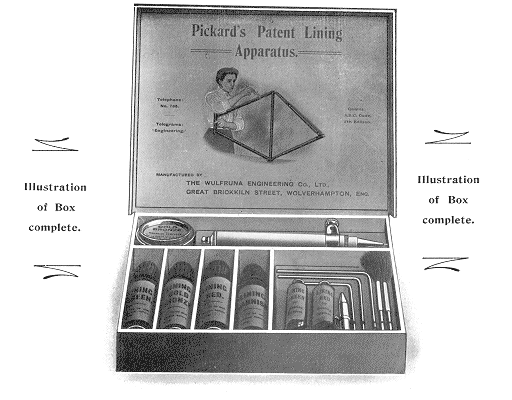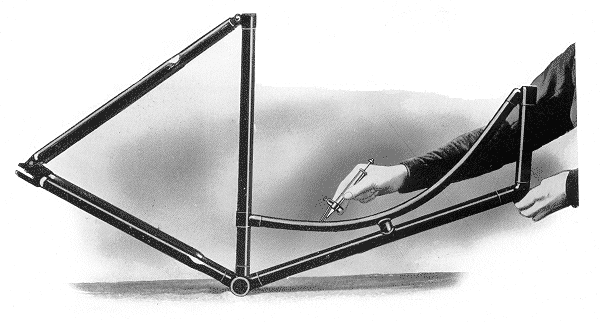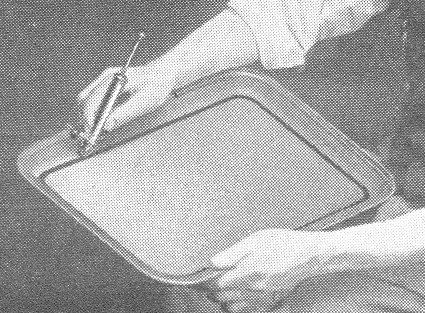| In the late 19th century, bicycle manufacturing
became an important industry in Wolverhampton, employing
many people. By the early years of the 20th century, the
number of manufacturers had fallen, but many of the
smaller businesses had been replaced by sizeable
factories, where large numbers of people assembled
cycles. The larger manufacturers such as Sunbeam, Star,
and Wearwell, produced a considerable number of
machines, most of which were lined, often in gold.
Lining was an extremely skilled occupation, usually
carried-out by a team of girls and women, mainly because
of the high level of dexterity required to achieve the
required results. Any labour-saving aid, that would
simplify, speed-up, and cheapen the process would be
warmly welcomed.
The Wearwell Cycle Company Limited had a large
factory in Pountney Street, producing all kinds of
cycles. Sometime after 1900 Mr. J. H. Pickard began to
develop a lining pen at the factory, to simplify and
cheapen the lining process. His initial apparatus used a
complicated and expensive set of guides, but appears to
have been successful.
The following details from 1910 give an impression of
the savings that were achieved at the Wearwell factory,
when using the Pickard lining apparatus.. |
| The initial development work at the factory ended in
1911 when Wearwell went into liquidation. William
Clarke, who had been running the company, purchased the
ailing Wulfruna Cycle Company based at Eagle works in
Great Brickkiln Street, and formed the Wulfruna
Engineering Company, to produce Wearwell and Wolf
cycles. |
| By this time Mr. Pickard had developed his patented
lining pen, a simple and cheap device that could be used
to line cycle frames, forks, and mudguards, at a quarter
of the cost of traditional brush lining. The old
method often took years to learn, whereas the lining pen
could be mastered in a few minutes.
The advantages of using the the lining pen, and its
potential market, must have been well understood by the
Wulfruna Engineering Company, because by 1912 it was manufacturing, and selling the product. |

Pickard's Patent Lining Apparatus. |

| The device is a type of syringe, consisting of a
metal tube, with a small diameter nozzle at one end,
through which the paint flows. At the other end is a
metal piston, and operating lever, to force the paint
through the nozzle. An adjustable guide is attached to
the side of the pen, to enable a line to be drawn
parallel to the side of an article. The lining pen is
held in the hand, in the same way as a writing pen.
|

| The paint supplied with the pen dries within a few
minutes, and can be coated with the layer of protective
varnish, applied with a camel hair brush. Both the
varnish, and a suitable brush are included in the box,
with the apparatus. |
|

Lining a gent's cycle frame. |
To line the top and bottom tubes of a gent's cycle
frame, the frame is held in the left hand, and rested on
the bench. The pen is held lightly, but firmly in the
right hand. To line the back and chain stays the frame
is simply reversed.
To line the seat tube, rest the frame on the back
fork ends. |
| A lady's cycle frame is lined in the same manner,
except that the frame is held slightly sideways to line
the loop tube. |

Lining a lady's cycle frame. |
|

Lining front forks. |
To line the front forks, the steering column is rested on the bench, and one
side of the lines on each fork are completed. The
forks are then reversed with the ends of the forks
pressing on the bench. The opposite lines are then
drawn. |
| To line a mudguard, place both ends on the bench as
illustrated, draw the line on one side, then reverse the
mudguard to draw the line on the other side. If a
central line is required, simply adjust the guide on the
pen, and draw the line where necessary. |

Lining mudguards. |
|

Lining a gear case. |
To line a gear case, hold it firmly in the left hand
and carefully draw the pen around the outside edge.
The guide will of course accurately follow the edge.
|
| To change colour, pour a small amount of turpentine
into a container, fill the nozzle, and press your
thumb on the end to squirt the liquid through the
nozzle, so removing any residual paint. The tube can
then be washed-out with turpentine.
When a large quantity of work is to be carried out,
it is worthwhile to have individual pens for each
colour, to reduce cleaning time. |
 |

A price list from 1912.

The product was in use at Sunbeam, as can be
seen from this testimonial.
|

An article from May, 1914. |
The lining pens would be a useful tool for anyone
repairing, or restoring a cycle, and also in
cycle shops, where cycles were often assembled to
individual customer's requirements. |

An advert from 1917.

Another advert from 1917.
| Manufacturing would have ceased in 1922 when the
Wulfruna Engineering Company closed, after the death of
its owner, William Clarke. Undeterred, Mr. Pickard
continued to develop his apparatus, and launched an
improved version, which was sold under the name Pickard
& Smith, based at 20 Paget Road. The improved pen
had a freely rotating hardened steel wheel, mounted in
front of the nozzle, to evenly spread the paint over the
surface. The special paint supplied for the apparatus,
contained varnish, so that is was no longer necessary to
apply a protective coat of varnish. |

The improved lining apparatus.
 |
The booklet that came with the
improved apparatus suggested a variety of applications
such as lining children's toys, or prams, or even lining
a tray. |
|
Lining a tray.
|
 |

A later price list.
 |
Return to
the
previous page |
|